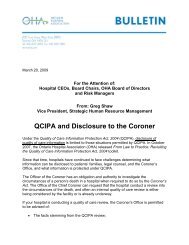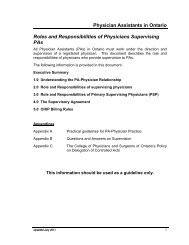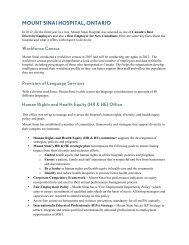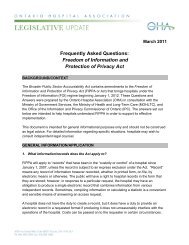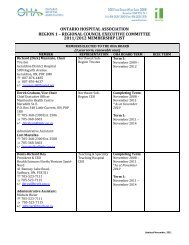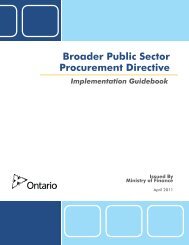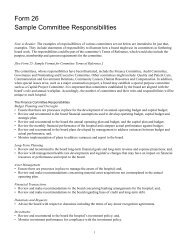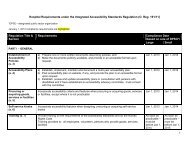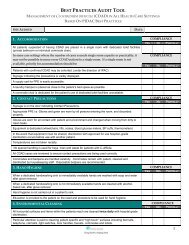The Relationship Between Employee Engagement and Human ...
The Relationship Between Employee Engagement and Human ...
The Relationship Between Employee Engagement and Human ...
- No tags were found...
You also want an ePaper? Increase the reach of your titles
YUMPU automatically turns print PDFs into web optimized ePapers that Google loves.
Department-level variations in engagement, retention <strong>and</strong> job stressIs there evidence of department-level variations in engagement, retention <strong>and</strong> job stress? To answerthis question, we conducted more in-depth analysis using EES data from Hospital A, Hospital B, <strong>and</strong>Hospital C.Looking first at Hospital C, three of the four departments with the lowest engagement scores also havebetween 40% <strong>and</strong> 51% of their employees planning to look for another job in the next 12 months. All ofthe departments in which 75% or more of respondents plan to stay with Hospital C have average orabove-average numbers in the high-engagement group. <strong>The</strong>re also is a relationship betweenengagement <strong>and</strong> self-reported work stress. For example, three departments with high engagementscores have low work stress levels. And two of the lowest-scoring engagement departments have highstress levels.At Hospital B we find a broadly similar pattern. Three of the four departments with the lowestengagement scores have between 31% <strong>and</strong> 55% of their employees planning to look for another job inthe next 12 months. All but one of the departments in which 75% or more of survey respondents plan tostay with the hospital have higher than average engagement scores. <strong>The</strong> department with the highestengagement score also has the highest percentage of employees planning to stay (88%). In terms of jobstress, employees in the two departments with the highest engagement levels report the lowest stresslevels. And employees in the four departments with the lowest engagement scores have above-averagelevels of job stress.<strong>The</strong>re are some interesting exceptions to note. For example, at Hospital B, one department has onlyslightly above-average employee engagement, yet survey respondents from that department are amongthe most likely to be planning to stay with the hospital – perhaps a function of the local labour marketfor that area of work. Another department at Hospital B has a below-average engagement score, yet iswell above-average in terms of intention to remain with the hospital <strong>and</strong> has low job stress. Clearly,there likely are unique dynamics influencing these findings.In sum, this analysis provides Hospital C <strong>and</strong> Hospital B with an important diagnostic that can be used toplan interventions: departments that have the lowest engagement also tend to be more stressful placesto work <strong>and</strong> are at risk of high turnover. Similar analysis was attempted for Hospital A. However, this is asmall hospital with only 106 EES respondents. Consequently, three of the four departments have toofew respondents to permit an accurate analysis of the relationship between engagement <strong>and</strong>,respectively, retention <strong>and</strong> job stress. Furthermore, if we look just at each of these three measures –engagement, retention, <strong>and</strong> job stress – we do not find statistically significant differences bydepartment. Such a finding may not be surprising given that Hospital A rates very positively on all thesemeasures compared to the other 15 hospitals exampled in the author’s 2012 Healthcare Quarterlyarticle.<strong>Engagement</strong> - <strong>Human</strong> Capital Performance Report11





